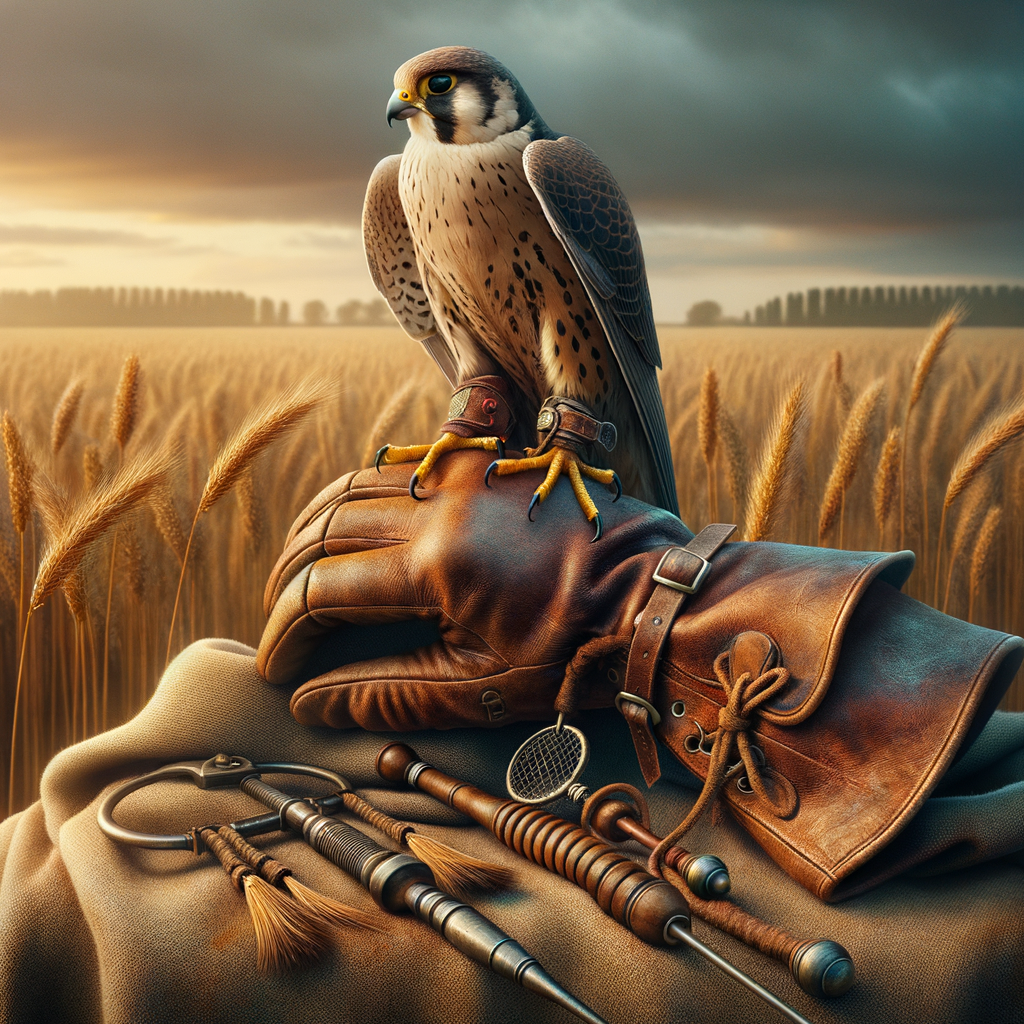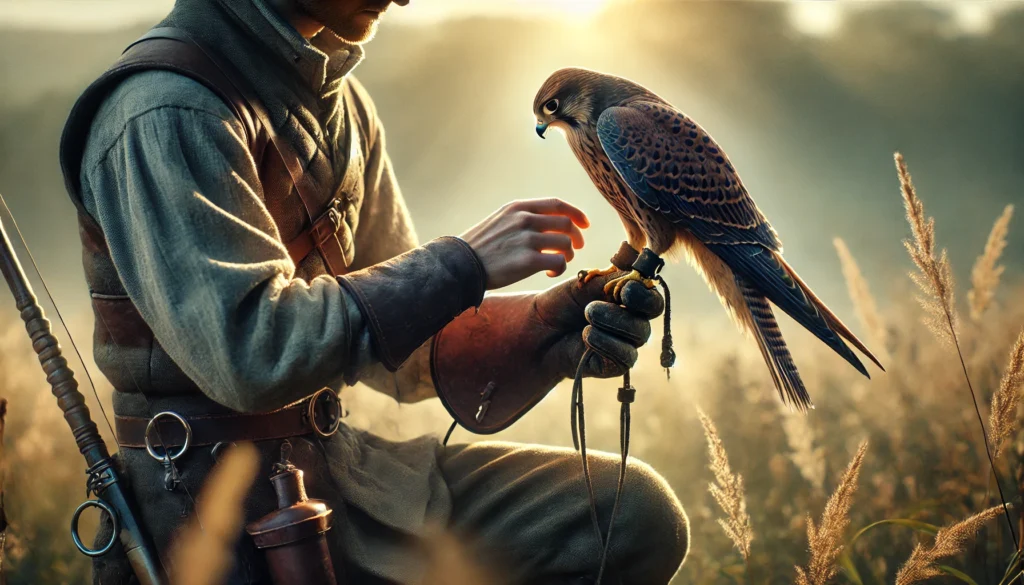Key Insights on Understanding Falconry Equipment
- Falconry is the art of training birds of prey to hunt in cooperation with humans.
- Essential equipment includes hoods, jesses, leashes, perches, and gloves.
- Hoods: Used to cover the bird’s eyes, keeping them calm and manageable.
- Jesses: Leather straps attached to the bird’s legs for control during training and hunting.
- Leashes: Used to secure the bird to a perch or the falconer’s glove.
- Perches: Provide a place for the bird to sit and survey its surroundings.
- Gloves: Protect the falconer’s hand and arm from the bird’s sharp talons.
- Knowledge of how to use this equipment properly ensures the bird’s safety and comfort.
Understanding Falconry Equipment: A Journey into the Heart of Falconry
Welcome to Learn Falconry, where we turn dreams of flying with majestic birds into a reality. Falconry, the ancient art of hunting with birds of prey, is a tradition steeped in history and wonder, and like any great epic tale, it begins with the right tools. Imagine setting off on a grand adventure through the rolling green hills of Ireland. Just like how a traveler needs sturdy shoes, a reliable map, and a trusted companion, a falconer needs essential equipment to thrive in their quest.
In this article, we’ll explore the key pieces of falconry equipment and explain why each one is crucial. Think of it as packing your bag for a magical journey. You wouldn’t go on an Irish trek without a raincoat, right? Similarly, understanding the equipment is essential for a successful and rewarding falconry experience.
So, stick around and dive into this fascinating world. Discover how every glove, hood, and leash plays a vital role in bonding with and training your bird of prey. Let’s get started on your path to becoming a skilled falconer with Learn Falconry!
Understanding Falconry Equipment: A Comprehensive Falconry Gear Guide
Welcome to Learn Falconry’s detailed guide on falconry equipment! Whether you’re a seasoned expert or a novice just getting started, understanding and using the right gear is essential to ensure both your safety and the well-being of your falcon. This section will break down the various types of gear you’ll need as you embark on this exciting journey.
Beginner Falconry Equipment Essentials
Before diving into the intricacies of falconry, it’s crucial for beginners to get acquainted with the basic gear. According to our beginner’s guide on falconry, the following equipment is indispensable:
- Gloves: Protect your hands from the bird’s sharp talons.
- Jesses and Leashes: Used to secure the falcon to a perch or your glove.
- Perches and Stands: Provide a safe place for the bird to rest.
- Bathing and Watering Equipment: Ensure the bird stays hydrated and clean.
You can find more detailed information about these essentials and where to buy them on our basic falconry equipment page.
Using Falconry Tools Effectively
Managing your falcon well relies on efficiently using specialized tools. Let’s explore some common tools and their uses:
What is a Falconry Hood?
A falconry hood is an essential item that covers the bird’s eyes, keeping it calm during transport or training. Different types of hoods are available, each with its own specific purpose and fit. Learn more about types of hoods and their uses.Bells and Telemetry: Bells attach to the bird’s legs, making it easier to locate them. For advanced tracking, telemetry and GPS trackers can be used, allowing you to monitor your falcon’s movements remotely. Discover more about bells and telemetry here.
Lures: A tool used in training to simulate prey and enhance the bird’s hunting skills. Read about different falconry lures and their applications in our training section.
Scales and Weighing: Keeping track of your falcon’s weight is critical as it directly affects their health and performance. Check out our guide to scales and weighing.
For a full list of essential tools and tips on their use, refer to our comprehensive guide on falconry equipment.
Advanced Gear for Experienced Falconers
As you progress in your falconry journey, you’ll need more sophisticated equipment. Advanced gear includes items like high-tech telemetry systems, specialized gloves, and custom perches. Experienced falconers can visit our advanced falconry section for more details.
Caring for Your Falcon and Equipment
Proper maintenance is crucial for the longevity of your gear and the health of your falcon. Regular cleaning and prompt repairs can prevent wear and tear. Visit our pages on cleaning and maintenance tools and basic falcon care for tips and guidelines.
Embark on your falconry journey equipped with the right tools and knowledge. Explore our pages on history of falconry and training a falcon for a deeper understanding of this ancient practice. If you’re a beginner, don’t miss our section on falconry for beginners to get started with confidence.
Stay tuned to Learn Falconry for more insights and updates!
Understanding Falconry Equipment in 2024
Falconry, the ancient art of training birds of prey, requires special tools and equipment to ensure the safety and effectiveness of both the birds and the falconers. Here’s a closer look at the essential gear needed for falconry in 2024.
Essential Falconry Equipment
Basic Gear for Beginners
- Glove: A robust leather glove is essential for handling and flying the bird. It protects the falconer’s hand from the bird’s sharp talons.
- Scale and Perch: A precise scale for daily weighing prevents health problems, and a sturdy perch gives the bird a place to rest.
- Jesses and Anklets: These are used to secure the bird’s legs and ensure it’s safely tethered without causing harm.
- Leash and Swivel: For walking the bird, these tools keep the raptor from flying away while offering some freedom of movement.
- Additional Perches: Having multiple resting spots is important for the bird’s comfort.
- Bath Pan: Regular bathing is crucial for the bird’s health, requiring a spacious and safe bath pan.
- Food Source: A consistent supply of appropriate food, such as rats, chicks, or beefheart, is necessary for a balanced diet.
- Mews: Proper housing that meets specific state guidelines and is inspected by a wildlife officer is crucial.
Falconry Gear Specifications
Portability and Durability
Falconry gear is designed to be portable and robust. This includes various tools like swivels, leashes, jesses, hoods, and telemetry devices. It’s advisable for falconers to keep extra gear, such as grommets, bells, and lures, as backups.
Weather-Resistant Equipment
The gear must be weather-resistant to protect both the birds and the falconers under different conditions.
Jesses and Leashes
Variety of Styles
Jesses and leashes come in many styles’snaps, swivels, buttons, and bullet ends’to cater to different training methods.
Materials and Customization
These are usually made from durable materials like leather and Dacron, and some suppliers offer customization options for specific needs.
Gloves
Layered Construction
Falconry gloves feature layered construction for strength, with multiple layers on specific fingers for increased protection.
Flexibility and Control
Despite their sturdiness, gloves are designed to be flexible for handling birds of prey effectively.
Telemetry
Signal Keeping and Testing
Telemetry tools, including weather meters, battery testers, and signal testers, help falconers track their birds and ensure their equipment is working correctly.
Falconry Hoods
A falconry hood is essential for calming the hawk by covering its eyes and beak. This allows safer handling. Different styles like Dutch, Anglo-Indian, and Arabic have unique shapes and patterns. Key considerations include proper eye clearance and beak opening to ensure a snug, comfortable fit. Hoods come in various sizes for different species and sexes, made from high-quality leather or breathable fabrics, sometimes with custom designs.
Example Data Table: Falconry Hoods
| Hood Style | Description | Species | Material |
|---|---|---|---|
| Dutch | Traditional design with round shape | Various hawks | Leather |
| Anglo-Indian | Smaller beak opening, fitted snugly over head | Kestrels, Merlins | Leather/Fabric |
| Arabic | Features embroidery and custom designs | Eagles, Falcons | High-quality Leather |
Prices of Falconry Equipment
Falconry equipment prices range widely depending on the item and brand. Below are some examples:
| Equipment | Price Range |
|---|---|
| Jesses | £5 – £20 |
| Gloves | £30 – £80 |
| Telemetry Kits | £100 – £500 |
| Hoods | £15 – £60 |
| Total Equipment Cost | £5 – £899.95 |
These price ranges provide a perspective on budgeting for different items based on their quality and brand.
This comprehensive overview should help anyone new to falconry understand the essential tools and equipment involved in the practice.
Mastering Falconry Equipment: A Path to Successful Falconry
Understanding and using falconry equipment effectively is crucial for anyone interested in the art of falconry. In 2024, falconers need to ensure their gear meets state-specific standards and is properly maintained. Key equipment includes gloves, scales, perches, jesses, leashes, baths, and appropriate housing. Each item, whether it’s the durable leather glove for handling your bird or the custom-designed jesses, plays a vital role in the safety and training of your raptor.
Moreover, having spare gear and weather-resistant items ensures that both the falconer and the hawk are prepared for various conditions. It’s also essential to be familiar with telemetry equipment to keep track of your bird during training sessions. By using high-quality and well-maintained equipment, you can ensure that your journey into falconry is both rewarding and enjoyable. Explore various options and find what best suits your needs as you continue to grow and learn in this fascinating sport.



